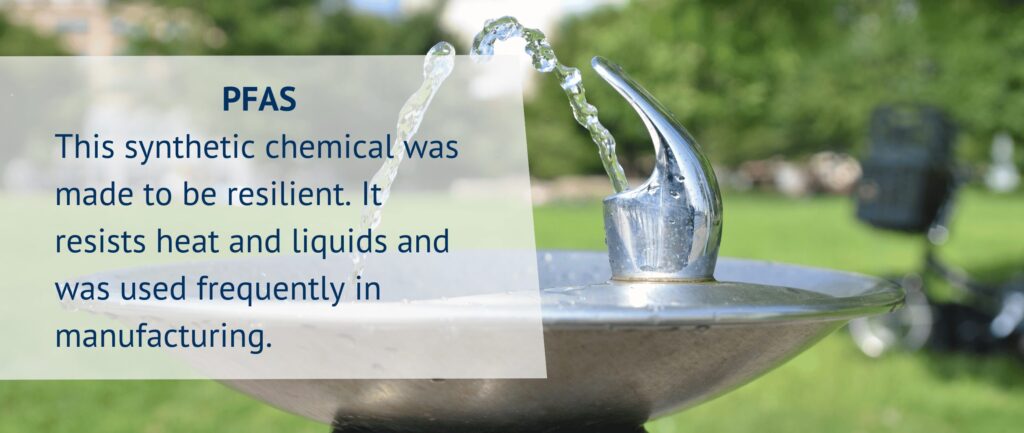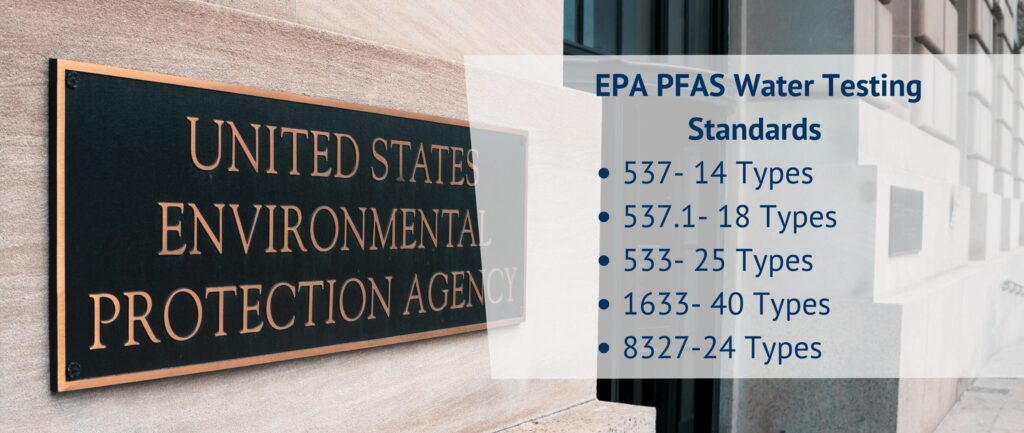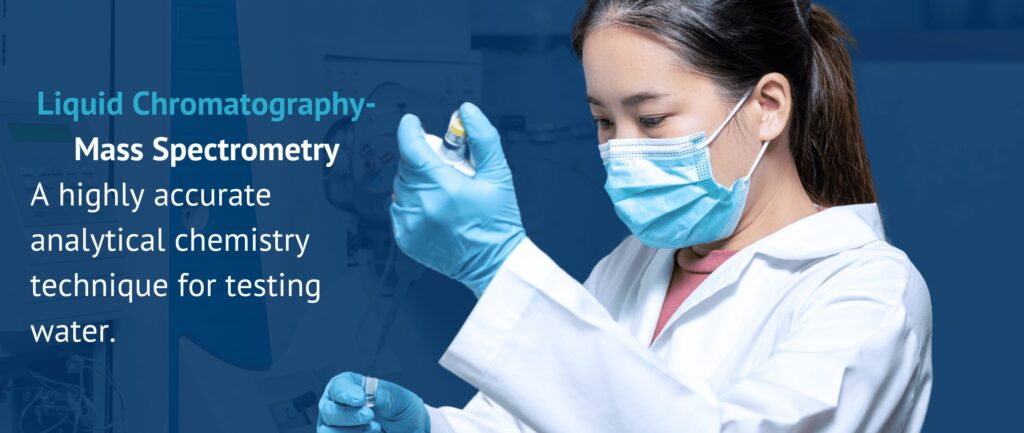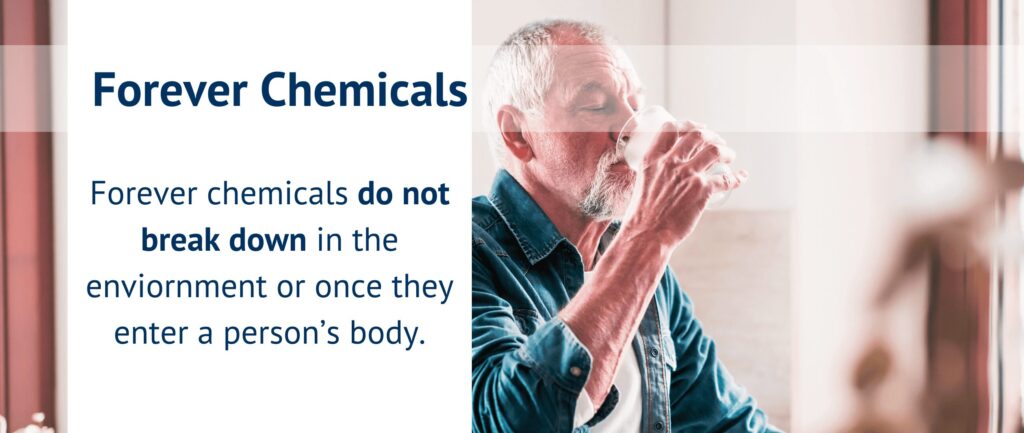
PFAS, often known as forever chemicals, are dangerous chemicals that should be sampled and tested for. Industrial facilities, landfills, and sewage plants are sources of PFAS that transfer to groundwater and surface water sources. This contamination eventually makes its way into drinking water. On April 10, 2024, the EPA announced drinking water standards to address PFAS forever chemicals. It regulates the parts per trillion of PFAS allowed in drinking water. Laboratory sampling and testing are currently the only way to accurately measure PFAS in potable water sources.

PFAS means perfluoroalkyl and polyfluoroalkyl substances. There are over 10,000 types of PFAS chemicals. They have been used for their unique chemical properties including liquid repelling, friction reduction, durability, and insulation. Their durability leads to them not degrading in nature, creating an environmental problem that is prevalent in most places. These PFAS compounds were created synthetically and were initially used commercially in 1938. The health implications of PFAS toxicity include liver damage, increased cholesterol, cancer, worse antibody response to vaccines, and birth complications. Around 45% of drinking water is estimated to have one of the types of PFAS present.
PFOA is a type of PFAS utilized for creating products with liquid-resistant properties. This chemical helps resist grease, stains, and water. Additionally, it has been used for firefighting and military applications. It was initially present in furniture, carpets/rugs, and non-stick cookware. Teflon and Gor-Tex were manufactured with this. PFOA was linked to kidney, testicular, pancreatic, and breast cancer. It also can disrupt endocrine hormones. There was a ban in 2014 on PFOA substances. PFOA can enter drinking water through manufacturing, particularly in the military, packaging, textile, electronic, cooking, and chemical industries. This waste makes its way into the water sources that our drinking water flows from. PFOA was an exceedingly popular chemical when it was utilized and so its remnants are widespread.
PFOS, Perfluorooctanesulfonic acid, was also widely used. This is also a type of PFAS. It had many applications such as in paints, wax, and non-stick coatings. 3M and DuPont utilized PFOS for fluoropolymers (heat-resistant surfaces). It was eventually banned in 2016. PFOS is estimated to be ten times more toxic in comparison to PFOA. These chemicals can vary greatly in terms of their toxicity levels to humans. PFOS leads to fertility problems, liver issues, thyroid disruption, and toxicity of several organs. Like other PFAS it makes its way to tap water from groundwater and surface water contamination by various industries that utilize the chemical.

Measures 14 types of PFAS. These substances are legacy contaminants that were banned in the U.S. yet can still be found today in tap water. These are long-chain substances being tested.
Measures 18 different PFAS types. It is a revision of the original 537 method, and it is now advised to use this new and improved version. This is a very commonly used test utilized.
This can be used in conjunction with method 537.1 as it tests for short-chain PFAS. It tests 25 various versions of PFAS.
As of January 31, 2024, this method is now a permanent method and is no longer a draft version. There is a total of 40 PFAS substances that can be measured with this method.
It is not as accurate as the alternatives, however, this method can measure 24 types of PFAS.
PFAS tests are more expensive than traditional potable water tests for contaminants such as heavy metals and bacteria. The cheaper the test is, the fewer compounds you will be able to test for, generally. Methods 537.1 and 8327 are currently the cheapest while methods 533 and 1633 are the most expensive. If you are testing water near common PFAS contamination sites such as a manufacturing plant, firefighting training facility, etc., then you should consider investing in tests that can detect more compounds. The equipment used for testing costs hundreds of thousands of dollars. Highly specialized lab technicians then need to operate this machinery and analyze the data. Ultimately, the choice is up to you based on your risk tolerance of PFAS forever chemicals.

Involves separating compounds, referred to as analytes, based on mass-based measurements. It is highly sensitive and accurate relative to historical testing methods. Liquid Chromatography separates analytes, starting with putting a sample solution into a moving solvent stream. This pumps through a column and mixes with another type of motionless solution. The interaction will then be measured. There are various types of chromatography that can measure this. There is partition, ion exchange, affinity, and size exclusion.
This next step creates a vacuum of pressure. The column flows into its interface and has heat applied to it. This heat evaporates the solvent, vaporizing and ionizing the analytes. This gas can then be analyzed by a mass spectrometer. In the spectrometer, electric/magnetic fields separate them. These separated ions are taken for detection by mass detectors (usually an electron modifier). These separated ions strike the surface of the electron multiplier. Secondary electrons are then released and put through dynodes. This amplified current is measured and compared to the ion concentrations in the mass spectrometer.

Once PFAS enters a human’s bloodstream they do not break down. The half-life (the time it takes for humans to get rid of substances in blood) is about 3-7 years. There are several health issues caused by PFAS like cancers, low birth rate, puberty acceleration, hypertension, decreased vaccine effectiveness, fertility issues, high cholesterol, liver damage, thyroid disease, and hormone issues. Lead only takes 32 days. Thankfully two types of PFAS are declining over time because of legislation to stop using these chemicals. PFOA blood levels were reduced by 70% and PFOS levels were reduced by 85%.